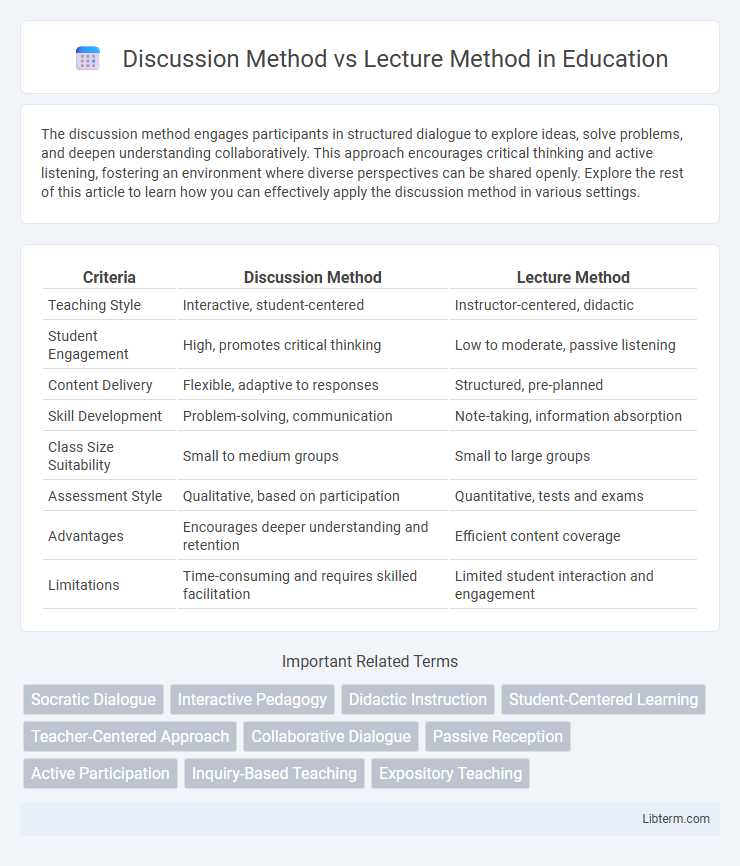The discussion method engages participants in structured dialogue to explore ideas, solve problems, and deepen understanding collaboratively. This approach encourages critical thinking and active listening, fostering an environment where diverse perspectives can be shared openly. Explore the rest of this article to learn how you can effectively apply the discussion method in various settings.
Table of Comparison
| Criteria | Discussion Method | Lecture Method |
|---|---|---|
| Teaching Style | Interactive, student-centered | Instructor-centered, didactic |
| Student Engagement | High, promotes critical thinking | Low to moderate, passive listening |
| Content Delivery | Flexible, adaptive to responses | Structured, pre-planned |
| Skill Development | Problem-solving, communication | Note-taking, information absorption |
| Class Size Suitability | Small to medium groups | Small to large groups |
| Assessment Style | Qualitative, based on participation | Quantitative, tests and exams |
| Advantages | Encourages deeper understanding and retention | Efficient content coverage |
| Limitations | Time-consuming and requires skilled facilitation | Limited student interaction and engagement |
Introduction to Teaching Methods
The Discussion Method fosters interactive learning by encouraging student participation and critical thinking, enhancing comprehension through dialogue and collaborative inquiry. The Lecture Method delivers structured information efficiently, suitable for presenting foundational knowledge to large groups but may limit student engagement. Combining both methods can optimize teaching effectiveness by balancing content delivery with active learner involvement.
Defining the Discussion Method
The discussion method is a learner-centered teaching approach that encourages active participation and critical thinking through open dialogue between students and instructors. It emphasizes collaborative exploration of ideas, fostering deeper understanding by allowing learners to articulate perspectives, ask questions, and engage in problem-solving. Unlike the lecture method, which primarily involves one-way information delivery, the discussion method creates an interactive environment that promotes communication skills and conceptual mastery.
Understanding the Lecture Method
The Lecture Method delivers structured content through direct verbal instruction, making it efficient for covering extensive material in a limited time. It emphasizes clear explanation and organized presentation, facilitating passive learning where students receive information without immediate interaction. While it may limit student engagement, the Lecture Method remains effective for conveying foundational knowledge and complex concepts systematically.
Key Features of the Discussion Method
The Discussion Method emphasizes active student participation, critical thinking, and collaborative learning through open-ended questions and dialogue. It fosters deeper understanding by encouraging learners to analyze, evaluate, and synthesize ideas collectively rather than passively receiving information. This method is characterized by interactive communication, diverse viewpoints, and a learner-centered approach that enhances retention and engagement.
Core Characteristics of the Lecture Method
The Lecture Method is characterized by a structured and teacher-centered approach where information is delivered verbally in a clear, organized manner to a large audience. It emphasizes the transmission of core knowledge, factual content, and key concepts efficiently, relying on listening and note-taking. This method supports systematic coverage of material but often limits immediate interaction and personalized feedback.
Advantages of the Discussion Method
The Discussion Method enhances critical thinking and active participation by encouraging learners to exchange diverse perspectives, promoting deeper understanding and retention of information. It fosters effective communication skills and collaboration, making learning more engaging and learner-centered compared to the passive absorption typical of the Lecture Method. Research shows that students involved in discussions demonstrate higher motivation and improved problem-solving abilities, leading to better academic outcomes.
Benefits of the Lecture Method
The lecture method efficiently delivers comprehensive content to large groups, maximizing time and resource use while ensuring consistency in information dissemination. It enhances instructor control over the learning pace and structure, facilitating clear communication of complex topics. This method is particularly effective for introducing foundational knowledge and theory before engaging students in interactive activities or discussions.
Drawbacks of Discussion and Lecture Methods
The discussion method can lead to time inefficiency and may cause confusion if participants lack sufficient background knowledge or if the conversation diverges from key topics. The lecture method often results in passive learning with limited student engagement, reducing retention and critical thinking development. Both methods face challenges in catering to diverse learning styles and maintaining consistent information delivery.
Comparative Analysis: Discussion vs Lecture
The discussion method fosters active student engagement and critical thinking by promoting interactive dialogue, whereas the lecture method primarily delivers content passively from instructor to students, emphasizing information transmission. Discussions enhance comprehension through diverse perspectives and collaborative learning, contrasting with lectures that focus on efficient coverage of extensive material in limited time. Research shows that combining both methods optimizes learning outcomes by balancing deep understanding with content mastery.
Choosing the Right Method for Effective Learning
Choosing the right teaching method depends on the learning objectives and student engagement levels; the discussion method promotes critical thinking and active participation, making it ideal for developing problem-solving skills. The lecture method efficiently delivers large amounts of information, suitable for foundational knowledge and large classrooms. Combining both methods can optimize learning outcomes by balancing content delivery with interactive dialogue.
Discussion Method Infographic

 libterm.com
libterm.com